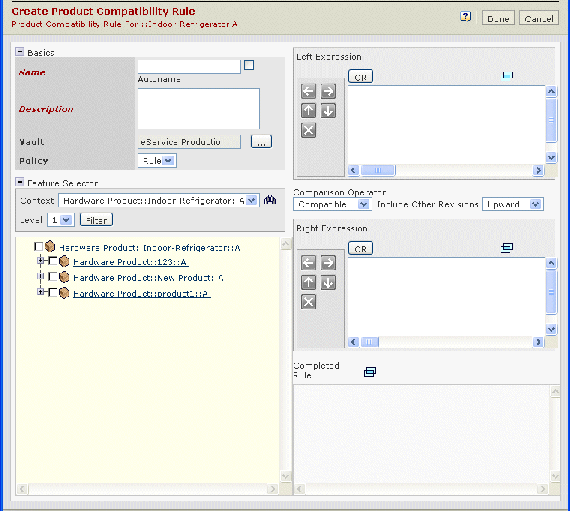Creating a Product Compatibility Rule | |||
| |||
To create a product compatibility rule, do one of the following:
- From the page Actions menu or page toolbar, click Create .
- To edit an existing product compatibility rule, click
 at the end of the row for the rule you want to edit.
at the end of the row for the rule you want to edit.
The Create Product Compatibility Rule page opens.

Type the details, as necessary. The following can be defined:
Name. Type the name of the new compatibility rule or check Autoname for the system to assign a name automatically.
Description. Type details that describe the rule.
Vault. If you want to use a vault other than the default, click
 to select a different
vault to specify where the rule information will be stored in the database.
For details, see
Selecting a Vault.
to select a different
vault to specify where the rule information will be stored in the database.
For details, see
Selecting a Vault.Policy. The policy is Rule.
The Basics table and the Feature Selector tables in the Create Product Compatibility Rule page can be collapsed
 and un-collapsed
and un-collapsed  to provide additional space for creating rules. Any
data entered in the tables is saved when the table is collapsed and reappears
when the table is un-collapsed.
to provide additional space for creating rules. Any
data entered in the tables is saved when the table is collapsed and reappears
when the table is un-collapsed.
Click
 to search for and select the products for the rule.
Only one object from the search results can be selected at a time. This
object is added to Context drop-down list. You can search for and select
an object to add to the list as many times as needed. Each object remains
in the list.
to search for and select the products for the rule.
Only one object from the search results can be selected at a time. This
object is added to Context drop-down list. You can search for and select
an object to add to the list as many times as needed. Each object remains
in the list.
From the Context drop-down list, select a product.
From the Level drop-down list, select a number from 1 through 10 to show the products that are connected as features to the product selected from the Context drop-down list. Select All to show products for all possible levels. Click Filter.
Select one or more products from the Feature Selector and click
 in the Left Expression field. The product is added to
the left expression.
in the Left Expression field. The product is added to
the left expression.
Click any of the following buttons to form the left expression:
-
Click
 to include other products in the expression.
to include other products in the expression.
-
Click
 to remove an item from the expression.
to remove an item from the expression.
-
Click
 or
or  to navigate through the expression.
to navigate through the expression.
-
Click
 to clear the expression.
to clear the expression.
-
Click
Repeat steps 7 and 8 until the required left expression is formed.
Select the Comparison Operator. The valid values are:
- Compatible. If two products can be included together, they are compatible.
- Incompatible. If two products cannot be included together, they are incompatible.
- Co-Dependent. If two products must be included together, they are co-dependent.
- Requires. If product A must be included whenever product B is included, but B doesn't have to be included when option A is included, then B requires A.
If you select Compatible or Incompatible, you must also specify one of the following options from the Include Other Revisions drop-down list:
- None. No revisions are included.
- Downward. Includes the existing lower revisions of the product that are present in the right expression.
- Upward. Includes the existing higher revisions of the product that are present in the right expression.
- All. Includes all revisions of the product.
If you are editing an existing rule and select Compatible or Incompatible as the Comparison Operator, you must also specify Yes or No from the Include Future Revisions drop-down list.
The current setting of the Include Future Revisions attribute depends on the value of Include Other Revisions set when the rule was created. Yes indicates a value of Upward or All. No indicates a value of Downward or None. Changes to this attribute are shown in the tables below.
- Yes. If any product revision that is present in the right expression is revised, then that also is connected to the Rule object.
- No. Future revisions of any product present in the right expression will not be connected to the Rule object. This is a virtual attribute which helps to set the Include Other Revision value.
The following explains the mapping of the Include Other Revision (from the Create page) and Include Future Revision (from the Edit page).
If you change from Yes to No:.
Include Future Revision (in Edit page)
(Before)
Include Future Revision (in Edit page)
(After)
Upward
None
All
None
If you change from No to Yes:.
From the Right Expression field, repeat steps 7 and 8 to form the right expression.
Click Done.